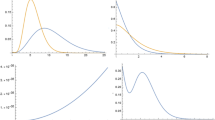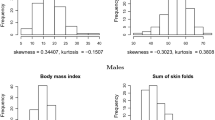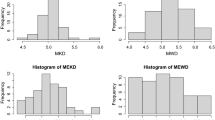Abstract
We propose two tests to distinguish between separable classes of distribution tails, the first of which is invariant with respect to the scale parameter and the second is invariant with respect to both location and scale parameters. The asymptotic properties of the proposed tests are established. The distributions are not assumed to belong to any maximum domain of attraction.
Similar content being viewed by others
REFERENCES
L. de Haan and A. Ferreira, Extreme Value Theory: An Introduction (Springer, New York, 2006). https://doi.org/10.1007/0-387-34471-3
J. Beirlant, Y. Goegebeur, J. Teugels, and J. Segers, Statistics of Extremes: Theory and Applications (Wiley, New York, 2004). https://doi.org/10.1002/0470012382
J. Hüsler and L. Peng, “Review of testing issues in extremes: In honor of Professor Laurens de Haan,” Extremes 11, 99–111 (2008). https://doi.org/10.1007/s10687-007-0052-0
M. I. Gomes and A. Guillou, “Extreme value theory and statistics of univariate extremes: A review,” Int. Stat. Rev. 83 (2), 263–292 (2015). https://doi.org/10.1111/insr.12058
S. Resnick and L. de Haan, “Second-order regular variation and rates of convergence in extreme-value theory,” Ann. Probab. 24 (1), 97–124 (1996). https://doi.org/10.1214/aop/1042644709
C. de Valk, “Approximation of high quantiles from intermediate quantiles,” Extremes 19, 661–686 (2016). https://doi.org/10.1007/s10687-016-0255-3
C. Albert, A. Dutfoy, L. Gardes, and S. Girard, “An extreme quantile estimator for the log-generalized Weibull-tail model,” Econ. Stat. 13, 137–174 (2020). https://doi.org/10.1016/j.ecosta.2019.01.004
C. de Valk, “Approximation and estimation of very small probabilities of multivariate extreme events,” Extremes 19, 687–717 (2016). https://doi.org/10.1007/s10687-016-0252-6
C. de Valk and J.-J. Cai, “A high quantile estimator based on the log-generalized Weibull tail limit,” Econ. Stat. 6, 107–128 (2018). https://doi.org/10.1016/j.ecosta.2017.03.001
J. Goegebeur and A. Guillou, “Goodness-of-fit testing for Weibull-type behavior,” J. Stat. Plann. Inference 140 (6), 1417–1436 (2010). https://doi.org/10.1016/j.jspi.2009.12.008
L. Gardes, S. Girard, and A. Guillou, “Weibull tail-distributions revisited: A new look at some tail estimators,” J. Stat. Plann. Inference 141 (1), 429–444 (2011). https://doi.org/10.1016/j.jspi.2010.06.018
M. Broniatowski, “On the estimation of the Weibull tail coefficient,” J. Stat. Plann. Inference 35, 349–366 (1993). https://doi.org/10.1016/0378-3758(93)90022-X
J. Beirlant, M. Broniatowski, J. L. Teugels, and P. Vynckier, “The mean residual life function at great age: Applications to tail estimation,” J. Stat. Plann. Inference 45, 21–48. (1995). https://doi.org/10.1016/0378-3758(94)00061-1
L. Gardes and S. Girard, “Estimating extreme quantiles of Weibull tail distributions,” Commun. Stat. Theory Methods 35 (4), 1065–1080 (2005). https://doi.org/10.1081/STA-200056849
C. Neves and M. I. Fraga Alves, “Testing extreme value conditions—an overview and recent approaches,” REVSTAT–Stat. J. 6, 83–100 (2008).
I. V. Rodionov, “A discrimination test for tails of Weibull-type distributions,” Theory Probab. Appl. 63 (2), 327–335 (2018). https://doi.org/10.1137/S0040585X97T989076
I. V. Rodionov, “Discrimination of close hypotheses about the distribution tails using highest order statistics,” Theory Probab. Appl. 63 (3), 364–380 (2019). https://doi.org/10.1137/S0040585X97T989118
I. V. Rodionov, “On discrimination between classes of distribution tails,” Probl. Inf. Transm. 54 (2), 124–138 (2018). https://doi.org/10.1134/S0032946018020035
N. S. Kogut and I. V. Rodionov, “On tests for distinguishing distribution tails,” Theory Probab. Appl. 66 (3), 348–363 (2021). https://doi.org/10.1137/S0040585X97T990447
I. V. Rodionov, “Inferences on parametric estimation of distribution tails,” Dokl. Math. 100 (2), 456–458 (2019). https://doi.org/10.1134/S1064562419050156
Funding
The research presented in Subsection 2.1 was performed by I.V. Rodionov at the Trapeznikov Institute of Control Sciences of the Russian Academy of Sciences and was supported by the Russian Science Foundation, project no. 21-71-00035.
Author information
Authors and Affiliations
Corresponding authors
Ethics declarations
The authors declare that they have no conflicts of interest.
Additional information
Translated by I. Ruzanova
Rights and permissions
About this article
Cite this article
Kantonistova, E.O., Rodionov, I.V. On Tests to Distinguish Distribution Tails Invariant with Respect to the Scale Parameter. Dokl. Math. 105, 97–101 (2022). https://doi.org/10.1134/S1064562422020119
Received:
Revised:
Accepted:
Published:
Issue Date:
DOI: https://doi.org/10.1134/S1064562422020119




